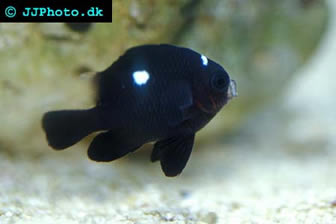Damselfish
All the members of the family Pomacentridae, expect for those belonging to the genera Amphiprion and Premnas, are referred to as Damselfish or Damsels. (The members of Amphiprion and Premnas are known as Clownfish / Anemone fish.) Most Damsels have a deep and compressed body with a small mouth. The largest species can reach a length of 35 cm (almost 1 foot 2 inches).
Damsels are popular in saltwater aquariums and many species are comparatively robust and hardy. Such species are a good choice for novice marine aquarists and are also commonly chosen by advanced marine aquarists to cycle newly set up aquariums. Even a small 100 L aquarium is large enough to keep certain damsel species, provided of course that you know how to keep the water quality up and the environment stable in a small aquarium. Damsel eggs are place on the bottom and guarded by the male fish. Several species of damselfish have been successfully bred in aquariums. Since certain Damsel species are much trickier to keep in captivity than others, it is important to research the particular species you are interested in before you make a purchase.
Since Damsels are a common choice for beginners and newly set up aquariums, some aquarists view them as “junk fish”. This is however very far from the truth; you can find a lot of beautiful, colourful and interesting members in the Damsel group, and many experienced aquarists with large aquariums do keep damsels.
All Damselfishes are marine creatures, but a few species can be encountered in the lower stretches of freshwater rivers. Damsels are present in all tropical seas, but they can also be found in certain temperate regions, such as the northern pacific coast of Mexico and the southern coast of California. A majority of the damsels are however native to the Indian Ocean and the tropical parts of western Pacific Ocean.
Damsels are not fuzzy eaters in captivity and they will normally accept a long row of different food. It is important to remember that some species are herbivore, some feed chiefly on plankton, and some are omnivore. Research your particular species to find out its feeding requirements. Providing your damsels with a varied and well balanced diet will prevent the risk of poor health in the aquarium.
Damsels are recommended for beginner marine aquarists, but it is important to keep min mind that damsels can be quite aggressive. Damsels are known to be territorial, especially if you keep older specimens, and they can attack other damsels as well as other fish in the aquarium. Some species will become extremely territorial as they grow older, while others are more docile.
If you want a fairly non-aggressive damsel you can for instance get a group of Chromis viridis. Always keep at least five specimens of this species together, preferably more. They may pick a little at the lowest ranking member of the group, but it will rarely result in injury. In the wild, Chromis viridis forms huge schools along coral reefs.
Damsel Species Articles
Green Chromis
Blue Green Chromis
Blue Devil
Blue Velvet Damsel
Yellowtail Damsel
Fiji Blue Devil
Striped Damsel
Blacktail Damsel
Domino Damsel
Clownfish Articles
Black Clownfish - Information about Black clown fish
Breeding Clownfish - A very brief describtion on how to breed clownfish
Cinnamon Clownfish - Information about Cinnamon Clownfish
Clarkii Clownfish - Information about Clarkii Clownfish
Maroon Clownfish - Information about Maroon Clownfish
Ocellaris Clownfish - Information about Ocellaris Clownfish
Percula Clownfish - An article about how to keep and breed Percula breeding.
Pink Skunk Clownfish - Information about Pink Skunk Clownfish
Saddleback Clownfish - Information about Saddleback Clownfish
Tomato Clownfish - An in deepth article about tomato clownfish.
Anthias
Aquarium Chillers
Basses
Batfish
Blennies
Butterflyfish
Cardinalfish
Clown fish
Corals
Damselfish
Files
Goatfish
Gobies
Gorgonians
Grammas
Groupers
Grunts
Hawkfish
Jawfish
Jellyfish
Lionfish
Dragonets
Mantis shrimp
Marine angelfish
Marine Catfish
Moray eels
Nudibranch
Octopus
Pipefish
Protein skimmers
Pufferfish
Rabbitfish
Rays
Snappers
Scorpionfish
Sea Anemones
Sea horses
Sea Stars
Shark Fish
Shrimps
Snails
Squirellfish
Surgeonfish
Triggerfish
Wrasses

